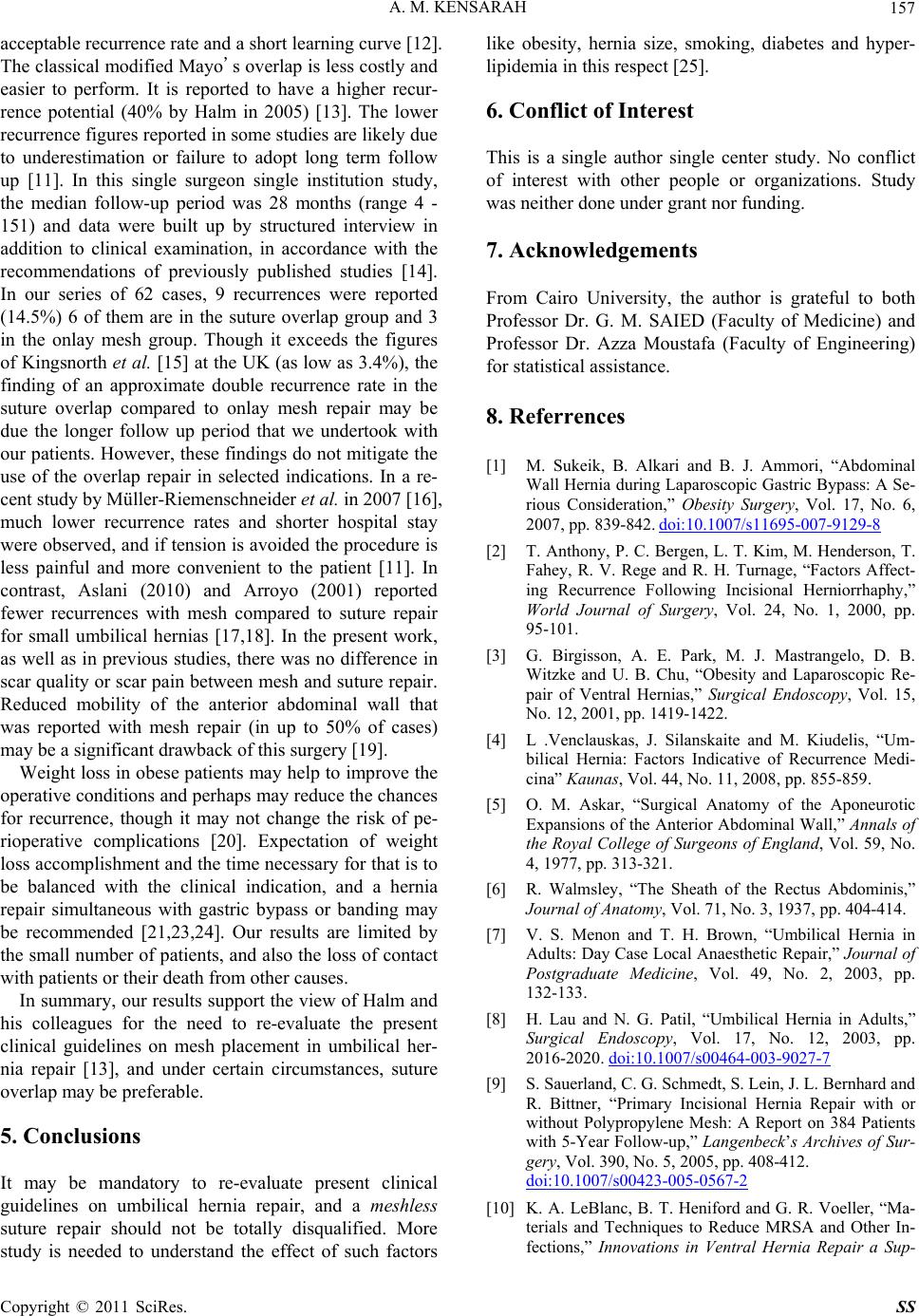
A. M. KENSARAH 157
acceptable recurrence rate and a short learning curve [12].
The classical modified Mayo's overlap is less costly and
easier to perform. It is reported to have a higher recur-
rence potential (40% by Halm in 2005) [13]. The lower
recurrence figures reported in some studies are likely due
to underestimation or failure to adopt long term follow
up [11]. In this single surgeon single institution study,
the median follow-up period was 28 months (range 4 -
151) and data were built up by structured interview in
addition to clinical examination, in accordance with the
recommendations of previously published studies [14].
In our series of 62 cases, 9 recurrences were reported
(14.5%) 6 of them are in the suture overlap group and 3
in the onlay mesh group. Though it exceeds the figures
of Kingsnorth et al. [15] at the UK (as low as 3.4%), the
finding of an approximate double recurrence rate in the
suture overlap compared to onlay mesh repair may be
due the longer follow up period that we undertook with
our patients. Ho wever, these findings do not mitig ate the
use of the overlap repair in selected indications. In a re-
cent study by Müller-Riemenschneider et al. in 2007 [16],
much lower recurrence rates and shorter hospital stay
were observed, and if tension is avoided the procedure is
less painful and more convenient to the patient [11]. In
contrast, Aslani (2010) and Arroyo (2001) reported
fewer recurrences with mesh compared to suture repair
for small umbilical hernias [17,18]. In the present work,
as well as in previous studies, there was no difference in
scar quality or scar pain b etween mesh and suture repair.
Reduced mobility of the anterior abdominal wall that
was reported with mesh repair (in up to 50% of cases)
may be a significant drawback of this surgery [19].
Weight loss in obese patien ts may help to improve the
operative conditions and perhaps may reduce the chances
for recurrence, though it may not change the risk of pe-
rioperative complications [20]. Expectation of weight
loss accomplishment and the time necessary for that is to
be balanced with the clinical indication, and a hernia
repair simultaneous with gastric bypass or banding may
be recommended [21,23,24]. Our results are limited by
the small number of patients, and also th e loss of contact
with patients or their death from other causes.
In summary, our resu lts support the view of Halm and
his colleagues for the need to re-evaluate the present
clinical guidelines on mesh placement in umbilical her-
nia repair [13], and under certain circumstances, suture
overlap may be preferable.
5. Conclusions
It may be mandatory to re-evaluate present clinical
guidelines on umbilical hernia repair, and a meshless
suture repair should not be totally disqualified. More
study is needed to understand the effect of such factors
like obesity, hernia size, smoking, diabetes and hyper-
lipidemia in this respect [25].
6. Conflict of Interest
This is a single author single center study. No conflict
of interest with other people or organizations. Study
was neither done un der grant no r fu n di ng.
7. Acknowledgements
From Cairo University, the author is grateful to both
Professor Dr. G. M. SAIED (Faculty of Medicine) and
Professor Dr. Azza Moustafa (Faculty of Engineering)
for statistical assistance.
8. Referrences
[1] M. Sukeik, B. Alkari and B. J. Ammori, “Abdominal
Wall Hernia during Laparoscopic Gastric Bypass: A Se-
rious Consideration,” Obesity Surgery, Vol. 17, No. 6,
2007, pp. 839-842. doi:10.1007/s11695-007-9129-8
[2] T. Anthony, P. C. Bergen, L. T. Kim, M. Henderson, T.
Fahey, R. V. Rege and R. H. Turnage, “Factors Affect-
ing Recurrence Following Incisional Herniorrhaphy,”
World Journal of Surgery, Vol. 24, No. 1, 2000, pp.
95-101.
[3] G. Birgisson, A. E. Park, M. J. Mastrangelo, D. B.
Witzke and U. B. Chu, “Obesity and Laparoscopic Re-
pair of Ventral Hernias,” Surgical Endoscopy, Vol. 15,
No. 12, 2001, pp. 1419-1422.
[4] L .Venclauskas, J. Silanskaite and M. Kiudelis, “Um-
bilical Hernia: Factors Indicative of Recurrence Medi-
cina” Kaunas, Vol. 44, No. 11, 2008, pp. 855-859.
[5] O. M. Askar, “Surgical Anatomy of the Aponeurotic
Expansions of the Anterior Abdominal Wall,” Annals of
the Royal College of Surgeons of England, Vol. 59, No.
4, 1977, pp. 313-321.
[6] R. Walmsley, “The Sheath of the Rectus Abdominis,”
Journal of Anatomy, Vol. 71, No. 3, 1937, pp. 404-414.
[7] V. S. Menon and T. H. Brown, “Umbilical Hernia in
Adults: Day Case Local Anaesthetic Repair,” Journal of
Postgraduate Medicine, Vol. 49, No. 2, 2003, pp.
132-133.
[8] H. Lau and N. G. Patil, “Umbilical Hernia in Adults,”
Surgical Endoscopy, Vol. 17, No. 12, 2003, pp.
2016-2020. doi:10.1007/s00464-003-9027-7
[9] S. Sauerland, C. G. Schme dt, S. Lein, J. L. Bernha rd and
R. Bittner, “Primary Incisional Hernia Repair with or
without Polypropylene Mesh: A Report on 384 Patients
with 5-Year Follow-up,” Langenbeck’s Archives of Sur-
gery, Vol. 390, No. 5, 2005, pp. 408-412.
doi:10.1007/s00423-005-0567-2
[10] K. A. LeBlanc, B. T. Heniford and G. R. Voeller, “Ma-
terials and Techniques to Reduce MRSA and Other In-
fections,” Innovations in Ventral Hernia Repair a Sup-
Copyright © 2011 SciRes. SS